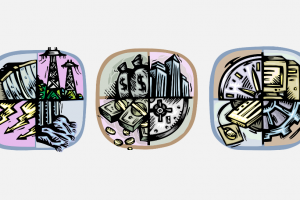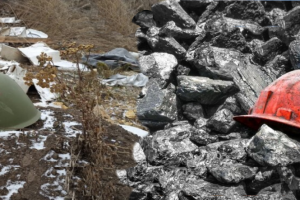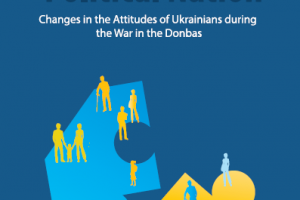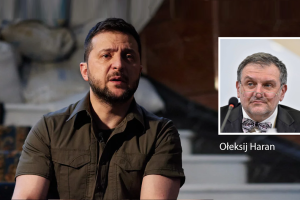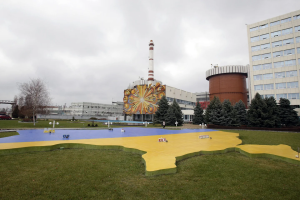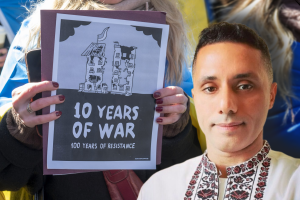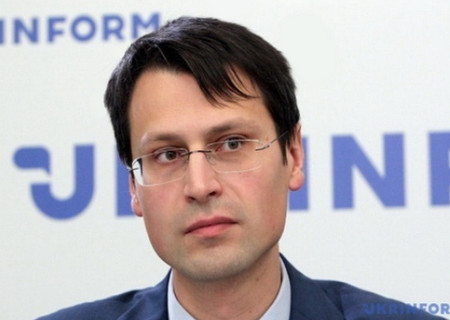
Executive Director

Research Advisor of the Ilko Kucheriv Democratic Initiatives Foundation, Professor of Comparative Politics at the National University of Kyiv Mohyla Academy
Source: G2W
In March 2020, one of the co-authors outlined five possible scenarios of development of the Ukrainian-Russian relations until the next presidential elections in Ukraine in 2024. In brief, we anticipated that 1) Russia would try to disrupt the peace process to coerce Ukraine to 2) a quick settlement of the conflict on the Russian terms or 3) “freeze” conflict in the Donbas. In case of failure of such attack or retreat we expect continuation of the 4) war of attrition, while the least likely scenario is 5) a gradual settlement based on the Ukraine's full territorial integrity.
They were published one year after a complete reset of the Ukrainian political system caused by a landslide victory of Volodymyr Zelenskyy, actor and co-owner of entertainment holding “Kvartal 95” without any political or administrative experience. Zelenskyy promised to find a solution to end the war, started by Russia in 2014 with occupation of Crimea and partial occupation of the Donetsk and Luhansk regions in the east of Ukraine, often referred as “Donbas” (Donetsk basin, a geologic formation known for the enormous deposits of black coal). At the same time, Russian authorities tried to frame his victory as a sign that Ukrainians disapproved policies of the former president Petro Poroshenko and were ready for concessions.
However, we argue that the domestic and international security context create serious obstacles for an exit from a dangerous confrontation. The events of 2021, namely an open Russian threat to use its armies against Ukraine, proved that estimated sequence probability of the proposed scenarios remain
Thus, we argue that comprehensive analysis of the Ukrainian foreign policy options demands closer attention to the Ukraine’s perceptions of the Russian actions and Ukraine’s decisions aimed at deterring and containing Russian threat. It will provide us a reason to update the scenarios and assess chances for the peace in Ukraine and in the Central and Eastern Europe.
Vladimir Putin has never made secret about his intention to turn CIS countries into the “friendly” vassal states, building an exclusive sphere of influence around what he called “resurging Russia”. However, only after attack in 2014 the Ukrainian government officially recognized Russian threat and started to assess potential Russian actions and possible responses, both domestically and internationally.
Between 2014 and 2020, Ukrainian national security authorities collected and analyzed evidence about different aspects of the Russian policy toward Ukraine. This work resulted in the revised text of the Strategy of the National Security of Ukraine and new Strategy of Foreign policy of Ukraine.
These documents outlined key areas of the biggest concern:
- Russian aggressive action in the Black Sea – Caspian Sea region.
- Russian subversive actions undermining political stability in the European countries, neighboring Ukraine.
- Russian occupation of the areas in the Donetsk and Luhansk regions.
It is important to admit that the Black Sea region has become a hotspot of the Ukrainian-Russian relations since mid-1990s when the two states had dispute about a division of the assets of the former Soviet Black Sea fleet. Although everything was settled in the 1997 treaties, since election of Vladimir Putin as Russian president relations began to deteriorate.
In 2003, first wake-up call rang when Kremlin contested Ukraine’s sovereignty of the territorial waters and the trading sea routes. Moscow used military engineers in the strait of Kerch trying to change the demarcation line and take over control of the maritime routs between the Sea of Azov and the Black Sea. The standoff with Ukraine ended in a framework legal agreement, which established mutual control and bilateral cooperation in the Sea of Azov.
In 2014, after the occupation of Crimea Ukraine has lost physical control over the pass between the Sea of Azov and the Black Sea. Russia swiftly stationed more warships in the Sea of Azov, started and completed construction of the bridge that connected its mainland with the Crimea. Under pretext of protecting the construction site, it started to stop commercial vessels going in and out of the Ukrainian ports in the Sea of Azov.
Since 2018, when three Ukrainian Navy ships were captured in the Strait of Kerch, Russia has been using this agreement to harass Ukraine’s international trade and fishing, openly violating its provisions, since they are written too broadly and allow different interpretations that Russia never wanted to clarify despite efforts of different Ukrainian governments between 2003-2014.
It appeared that Kremlin is going to abuse bilateral agreements with Ukraine as soon as their provisions allow intimidating the neighbor.
The latest example was Russian Navy military drills in the Black Sea in February 2022, when the Command of the Russian Black Sea Fleet declared a restricted area in the high sea covering major trading routes from the Ukrainian ports to the Bosporus. Since these routes are vital for 60% of the Ukrainian exports, the Ukrainian government perceive the Russian actions as unveiled blackmail slightly short of a complete sea blockade.
Ukraine has several options to respond to this kind of treatment. First, accession to NATO is the best response since Russia, so far, never questioned or disrupted trading sea routes of the NATO members in the Baltic Sea. The regional security arrangement with the NATO members, which have coast in the Black Sea is much weaker option, since Turkey, the strongest regional country, clearly avoids direct confrontation with Russia, unless it is backed by the US power.
The build-up of the Ukrainian Navy and establishment of the anti-ship missile batteries may be a way to protect Ukraine ports from aggression. However, it do not stop the Russian Navy from closing trade routes under pretext of training.
The possible available option is a construction of the permanent sea outposts in the Ukrainian exclusive economic zone and along the trade routs, starting from the isle of Zmiinyi in the Black Sea. The technologies of construction will be similar to oil and gaz exploration platforms and their legal status as commercial objects will be protected by the international commercial law, which Russia is not ready to violate since it can backfire its companies. These platforms, armed with the anti-ship missiles and defended by inshore anti-aircraft batteries, can become an asymmetric response to the Russian naval domination in the middle to long-term.
The Ukraine’s relations with the European countries, especially former Soviet republics and members of the Warsaw Pact, were in focus of the Russian foreign diplomatic and propaganda activity and, in case of Moldova, of military coercion.
The long-term objective of these efforts is to surround Ukraine with the states that are either Russian vassals or hostile toward Ukraine’s sovereignty and interests. In this respect it is necessary to look at examples of Moldova and Belarus.
In 2003, Putin’s close associate Dmitriy Kozak attempted to impose a plan of Moldova’s “federalization” as a “peaceful resolution” of a decade long conflict between Moldova and unrecognized “Transnistrian Moldovan Republic”, a Russian controlled and managed enclave. That time the plan was rejected even by Moldova’s ruling Communists who found themselves in consensus with the pro-European opposition.
Although the outcomes of the presidential elections in 2020 significantly reduced the risk of turning Moldova into a Russian vassal state, there is evidence of long-term implications of political scheme that Russia tried to implement in Moldova.
In 2014, Russian authorities used the same model of “federalization”, tool of “special status” and creation of the controlled proxy entities, disguised as “people’s republics” to mask its intervention in the several regions of Ukraine. While in Odesa and Kharkiv regions they failed, in the certain areas of the Donetsk and Luhansk regions these proxy “republics” were established after direct military intervention and preliminary peace.
Moreover, Deputy Head of Administration of President of the Russian Federation Dmitriy Kozak represents Russia in the “Normandy Four” negotiations format demanding that Ukraine must accept “special status” of the Russian-occupied areas of Donbas, which Kremlin propaganda has been framing as “people’s republics” since 2014. The key elements in this “special status” are very similar to the “special status” of “Transnistria” which he tried to enforce in Moldova in 2003.
From the Ukrainian perspective, these proposals of political arrangements, framed by Russia as reasonable compromises, are detrimental for the security of the country in the middle term. Russia use them to influence the Ukrainian public perception of what is “security” and “acceptable peace conditions”, while giving the Russian authorities a status of “mediator” and the ultimate legal and cognitive power to decide when its security and interests are threatened or violated.
Another example of Russian efforts to encircle Ukraine and restore hegemony in the CIS space is a gradual incorporation of Belarus. In August 2020, amid mass protest of Belarussians against the falsified presidential elections and self-proclaimed victory of Aliaksandr Lukashenka, one of the authors anticipated that the country would transform in a police state and a base for military threat to Ukraine. It took a year for Kremlin to receive total approval from Lukashenka to use the territory of Belarus for the military drills that included scenarios of assault against the Ukrainian army.
Again, the best response to these kinds of Russian actions in the neighboring countries is an accelerated process of getting NATO membership. Before it becomes politically available, Ukraine would try to mitigate existing risks (in case of Belarus) and prevent new attempts of the Russian assertiveness.
The risk mitigation efforts include building international coalition in support of the gradual but complete restriction of the trade and investment in Belarus and Russia. Hard economic sanctions against Belorussian regime, including possible unplugging of SWIFT, can become an example of consequences for aggressive behavior and a strong message to Kremlin.
All members of the armed and security forces must be banned from entry to European countries for participating in the actions that support repressive regime. Another component is enhancing security and defence cooperation with the countries that have borders with Russia and Belarus, including joint training to repel the full scale and hybrid attacks with propaganda and cyber operations.
However, the most serious challenge to Ukraine’s security remains the Russian military presence in Crimea and in the Donetsk and Luhansk regions. Today, Russia threatens to recognize proxy entities, established in the occupied Donbas, as “independent states”, and legitimize its open military build-up in the region.
In order to continue this game on its own terms, the Kremlin must either deliver its threat and start an invasion of Ukraine, or find a way to increase pressure on the West, or pretend that it got what it wanted.
Kremlin’s official recognition of the occupied territories of Donbas as “independent states” automatically means direct Russian protectorate. On the one hand, Russian authorities may call it a “victory” and an acceptable exit from the current confrontation. In this case, Ukraine remains vulnerable to the new Russian attacks in the near future. Furthermore, Russia will not give up attempts to coerce Ukraine to the direct talks with the new “states” as a way to stop the war. Meanwhile, it will continue economic and social incorporation of the occupied territories.
However, Kremlin can increase its pressure on Ukraine without starting a war or recognizing its proxies in Donbas. After creating a plausible threat of imminent attack, Russia can use it to push the key European countries, like Germany and France, so they force Ukraine to concessions regarding “special status” of Donbas and neutral status in exchange of de-escalation.
Although it might sound as a good alternative to war, from the Ukrainian perspective it means growing risk of domestic unrest. According to the nationwide polls, conducted by Ilko Kucheriv Democratic Initiatives Foundation in 2019-2021, the majority of Ukrainians reject compromises that include key elements of the “special status” (autonomy, amnesty, local elections). Moreover, in the nationwide poll, conducted in December 2021, 64% of respondents believed that the occupied territories must return under Ukrainian sovereignty on the pre-war conditions (54%) or with extended self-government powers (10%), while only 13% supported their full autonomy. If the government gives in to the Russian demands it will face a strong popular backlash and protests against such decision.
Therefore, one of the most urgent tasks of the Ukrainian government in the next two years is to explain the western partners why the Minsk agreements cannot be implemented and propose an alternative based on the international law principles.
One of the ways to this end is a revival of idea of the UN peacekeeping mission in Donbas. It was proposed by the Ukrainian president in March 2015 and until 2019 advocated on the different international platforms, including the Council of Europe, NATO and OSCE, and within EU institutions like European Parliament, and in bilateral contacts with other states.
Ukraine may also use this option to reveal true motives of the Russian foreign policy in the Eastern Europe and in the UN Security Council. If Moscow rejects or vetoes the idea of UN peacekeeping mission in Donbas, then Ukraine will have a legitimate right to search for other collective security mechanisms, whether NATO or multilateral defence treaties with other European nations.
Aftermath of War: Ukraine's Security Options
On February 24, 2022, Putin, as we anticipated, chose to deliver his threat and ordered an invasion. The moves of the Russian troops clearly demonstrated that Kremlin is dedicated to take over the whole country.
As we outlined, occupied Crimea and Donbas have been used as launch pads for offensive against Ukrainian south and the Black Sea ports. However, Russian army concentrated major efforts on seizing Kyiv, the Ukrainian capital, with advances from north and northeast (both from Belarussian territory) and east. Second largest city of Kharkiv also appeared as an important goal.
Fierce and effective defence of the Ukrainian army surprised everybody and became a crucial factor, which opened the way for diplomatic endeavors about variants of exit from the war. While Russia starts looking for a ceasefire to secure newly occupied territories in the south and east of Ukraine, Ukraine expects to gain an upper hand in negotiations due to the successful actions of her Armed Forces.
Another important factor, we would argue, is the Order issued by the UN International Court of Justice on March 16, 2022. The ICJ admitted the fact that “The “special military operation” being conducted by the Russian Federation has resulted in numerous civilian deaths and injuries. It has also caused significant material damage, including the destruction of buildings and infrastructure”. This sets a legal framework for any future talks involving Ukraine and Russia whether about short- or long-term security arrangements.
From the practical point of view, it is hard to find a solution that can bridge differences of Ukrainian and Russian security perceptions. Furthermore, Russian regime refuses to recognize Ukrainian government as a legitimate party of the peace talks and that Ukrainian position must be regarded and accepted as equal to Russian.
So far, it is impossible to speak about any interim armistice, which stops the fighting on the ground but leaves key issues between Ukraine and Russia unsettled. Similar to the Minsk agreements, such temporary ceasefire would only encourage Russia to prepare another invasion against Ukraine weakened by the war.
Thus, we think that such breakthrough in the peace talks can happen only after a major Russian defeat either in the northern or southern front. In the diplomatic dimension, Russian seriousness about peace talks depends of its readiness to give up control over territories in Donetsk and Luhansk regions, occupied in 2014-2015.
The West must accept that the continuation of the war remains an alternative to such serious negotiations. The sooner Ukraine obtains enough capabilities to win superiority in the battle for control of the skies the stronger chances it have to force Kremlin to consider peace talks.
Moreover, vice versa, the more gains Putin’s armies achieve in Ukraine the stronger his desire to project his power of intimidation in the Central and Eastern Europe will be. We cannot rule out that the next step would be deployment of Russian troops in Serbia and even Bosnia and Herzegovina and decision of, let’s say, Hungarian government so exit NATO or veto further EU sanctions against Russia.
When Ukraine starts prevailing in the war, we can see two ways, namely de-escalation and escalation of the war, which will depend on Russian assessment of capabilities to enter and win a protracted war.
If the cost of such escalation is considered too high and dangerous for economy and domestic social stability, then the Kremlin could afford and exit facilitated by UN Security Council decision to put multinational peacekeeping force on the line of contact in Crimea as of February 23, 2022. All the rest territories must be returned to Ukraine and Russia must agree to jurisdiction of International Court of Justice regarding future compensation of damages.
Still, the most contentious issue is the future of Crimea. They were illegally occupied but Russian leadership committed to protect its seizure by the nuclear arms. However, it is also known that Russian strategists considered that takeover of Crimea was justified by concerns that it would have been used as a base of American-led, or any other anti-Russian, military forces in the future. At the same time, Crimea under Russian rule is a permanent reminder of violation of the security guarantees, threat to eastern and southern regions and testimony of massive human rights abuses against Ukrainians and Crimean Tatars.
So, is it possible to address concerns of the both sides in a practical and business manner? We think it is if Russia can be serious and cooperative toward international security mechanisms, specifically under UN auspices.
In Donetsk and Luhansk regions all people, who did not commit war or other heavy crimes, must have right to choose where they want to live. And if they choose Russia, then they should be provided with financial aid to settle there and allowed to keep their property in Ukraine.
Demilitarisation and denuclearization of Crimea, establishment of the UN Trusteeship over peninsula and consociational government, in which Crimean Tatars, Ukrainians and Russians have common responsibility for the regional development and fair redistribution of resources among steppe and seaside communities can be discussed as a possible interim solution.

